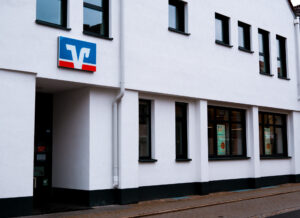Table of contents
ToggleThere are few areas of daily life as impacted by the pandemic as the workplace and the workplace model. McKinsey reports that before the pandemic, 61% of employees worked full-time on-site, but after the pandemic, only 37% did. And more than half of workers today want a hybrid model. (1)
Let's take a look at what is expected of the workplace and what role digitization plays in this.

What are the implications of hybrid and remote working for physical office environments?
The emergence of hybrid and remote work has significant implications for physical office environments. In a hybrid work model, employees split their time between working in the office and working remotely, while in a full remote work model, they don't come into the office at all.
One of the most significant impacts of this type of work on physical office environments is the reduction in space requirements. The fewer employees who come into the office on a regular basis, the less demand there is for workstations, which can lead to a downsizing or repurposing of office space.
Another impact is the need for a more flexible and adaptable office design. In a hybrid work model, offices need to be able to accommodate both face-to-face and remote workers, which may require a more flexible and adaptable workplace design. This can include things like dedicated spaces for video conferencing, as well as flexible furniture and layout options that can be easily reconfigured to support different types of activities.
The rise of hybrid and remote work is driving changes in physical office environments as companies adapt to the changing needs and preferences of their employees.
Workplace of the future
Exactly what a future modern workplace will look like is difficult to predict, as it depends on a number of factors, such as technological advances, changes in the global economy, and shifts in employee preferences and expectations.
However, there are some trends and developments that will shape the workplace of the future. Some of the most important ones that will impact it are:
- Increased use of remote and hybrid work models: The modern workplace will likely be characterized by increased use of these as companies seek to support flexible work arrangements and tap into global talent pools.
- Greater emphasis on the employee experience: the workplace of the future is also likely to place greater emphasis on the employee experience as companies seek to improve job satisfaction and retention and attract and retain top talent.
- Increased use of artificial intelligence and machine learning: It is also likely that AI and machine learning will be used more frequently as companies seek to automate and optimize their operations and give their employees access to more advanced tools and technologies.
- Greater focus on sustainability and social responsibility: The workplace of the future is also likely to have a greater focus on sustainability and social responsibility as businesses seek to minimize their environmental impact and support social and economic development.
- Ongoing development of digital technologies and tools: Ultimately, the modern workplace will also evolve and advance as innovations emerge and are deployed. This could include things like virtual and augmented reality, blockchain, and the Internet of Things.

What role does the "experience" play?
The term workplace or employee experience refers to the overall satisfaction and well-being of employees at their desk plus its surroundings. This includes factors such as the physical work environment, company culture, opportunities for growth and development, and management support. A positive employee experience can lead to higher job satisfaction, motivation and productivity, while a negative experience can have the opposite effect. The term is often used in the context of initiatives and strategies aimed at improving the employee "experience" in the workplace.
What does this have to do with the term "modern workplace"?
The term "modern workplace" refers to the use of digital technologies and tools to support and enhance the employee work experience. A modern workplace typically includes a range of technologies and services, such as cloud-based collaboration and communication tools, mobile devices, and digital security and privacy controls.
The concept of the modern workplace is driven by the need for organizations to adapt to the changing expectations and needs of their employees, as well as the increasing importance of digital technologies. This can help improve productivity, teamwork and information sharing, and provide employees with the tools and support they need to succeed.
In addition, a modern workplace can also support the aforementioned flexible work arrangements, such as remote and hybrid work models, which can help improve the employee experience and reinforce the needs of a diverse and global workforce.
With this in mind, what tools and technologies can support a positive workplace experience?
There are a few ways that can support a positive desk experience. Some examples are:
- Communication and collaboration tools such as Slack, Microsoft Teams and Google Workspace that can help workers stay connected and collaborate effectively.
- Project management tools like Asana and Trello that can help teams organize and track their work.
- Time tracking and productivity tools like Toggl and RescueTime that can help workers manage their time and increase productivity.
- Employee engagement and feedback tools, such as CultureAmp and OfficeVibe, that can help managers gather and act on feedback from the workforce.
In addition to these tools, there are also a number of technologies that can improve the physical work environment, such as ergonomic furniture, smart lighting and temperature control systems, and noise-canceling headphones. Employers can also use tools to promote work-life balance, such as offering remote work options or flexible work schedules. Overall, the goal is to make the workplace more efficient, comfortable and enjoyable for employees through the use of technology.
Modern Workplace for your company?
We offer an individual, tailor-made full service for your Modern Workplace project
including conception, implementation and after-sales service. Contact us without obligation for an initial consultation.
What role does software play in these "tools"?
Let's take Microsoft as an example - What is Microsoft365 and why is it relevant to enterprises in the digital workplace?
Microsoft 365 is a subscription-based service that gives businesses access to a range of productivity and collaboration tools and services. It includes popular applications such as Microsoft Office, Exchange Online and Teams, as well as cloud storage and security services.
Tools like Microsoft 365 are important to companies because they can help improve productivity, teamwork and understanding. For example, employees can access the latest versions of popular productivity applications such as Word, Excel and PowerPoint. This can help improve efficiency and facilitate collaboration on shared documents and projects, among other things.
In addition, Microsoft 365 includes services such as Exchange Online and Teams, which can support teamwork and contact within and between companies. This can include things like video conferencing, real-time messaging, and document sharing and sharing alike, including the latest version.
What are the reasons for investing in digital technologies for the workplace?
The tools and technologies that support a positive workplace experience can directly impact each KPI:
- Improved information sharing and collaborative work: Digital tools can make it easier for employees to communicate and collaborate regardless of their location. This can help teams stay connected and work more efficiently.
- Increased productivity: They can be an aid for employees to manage their time more effectively, track their progress and automate routine tasks. This gives employees more time to focus on high-value tasks.
- Better work-life balance: Digital tools and technologies can support flexible work arrangements, such as remote working and flexible scheduling. This can help Allen achieve a better work-life balance.
- Better employee experience: A digital workplace can provide the team with a modern, intuitive and user-friendly environment. This can lead to higher job satisfaction and a more positive overall experience for employees.
Overall, investing in a digital and modern workplace can help companies stay competitive, as well as attract and retain top talent.

Let's take the example of a meeting room
A well-furnished meeting room can be important to businesses for several reasons. It can help create a professional and welcoming environment that can make meetings more productive and effective. It can also promote collaborative work and understanding between team members.
The meeting room should be equipped with the necessary technology and tools to meet the needs of the meeting. These include, for example, a large screen for presentations, a high-quality audio system for clear communication, and a reliable Internet connection for video conferencing. The room should also be designed to encourage collaboration and facilitate group discussions.
The environment should not only be functional, but also comfortable and conducive to concentration. This includes, for example, comfortable seating, adequate lighting and good air quality. This way, nothing stands in the way of an efficient meeting that is more pleasant for all participants.
What are the most important technical elements in video conferencing?
The key technical elements in videoconferencing can vary depending on the specific needs and goals of the organization. However, some general technical elements that are important in video conferencing are as follows:
- High-quality cameras and microphones: For effective video conferencing, it is important that the cameras and microphones are of high quality and provide clear and sharp audio and video transmission. This can help improve the overall experience for participants and make it easier to see and hear each other.
- Fast and reliable internet connection: Video conferencing requires a fast and reliable internet connection to ensure high quality audio and video. This can help ensure that the video conference is not interrupted or disrupted by connection problems.
- Advanced video and audio processing: Many video conferencing systems also offer advanced video and audio processing features such as noise reduction, echo cancellation, and automatic gain control. These features can help improve the overall quality of audio and video and make the videoconference more comfortable and enjoyable for participants.
- Compatibility with different devices and platforms: It is also important that video conferencing systems are compatible with a variety of devices and platforms, including smartphones, tablets, laptops and desktop computers. This can help ensure that participants can join the video conference from any location and with any device.
- Security and privacy features: Finally, it is important that video conferencing systems include robust security and privacy features, such as encryption.
Can digital signage support communication in the workplace?
Yes, digital signage can play a role in workplaces. In the workplace, digital signage can be used for a variety of purposes, including
- Conveying important information: Digital signage can be used to display messages and announcements to employees. This can include things like company updates, news, and information about upcoming events or training opportunities.
- Providing directions and guidance: Digital signage can help employees navigate the office and find their way to different locations. This can be especially useful in large or complex office buildings.
- Enhancing the aesthetics and ambiance of the corporate campus: Digital signage can be used to enhance campus aesthetics and ambiance by providing visually appealing content. This can include things like wayfinding and navigation, branding and marketing, and arts and entertainment.
- Support collaboration and teamwork: Digital signage can also be used to support collaborative work by providing access to digital tools and resources that can facilitate collaboration. As mentioned earlier, this can include things like shared calendars and task lists, video conferencing, and document sharing.
- Improving the customer experience: For companies that have customers on their premises, digital signage can be used to improve the customer experience by providing personalized and engaging content. For example, this can include product recommendations, promotions and offers, and interactive experiences.
- Improve site security: Digital signage can provide security-related information and alerts with real-time monitoring and control. This can help keep employees, visitors and other stakeholders safe.
What is the most important technical equipment at individual workstations in corporate offices?
Key tech devices can vary depending on the specific needs and requirements of the organization. However, some common ones that are often found on desks are as follows:
- Computer: Most employees in corporate offices have a computer. Either a desktop or a laptop that they use for their employment. The type of computer depends on the specific needs of the employee and the tasks they need to complete. Stationary computers are now only used in exceptional cases.
- Monitors: In addition to a computer, many employees also have one or more monitors on their desks. This gives them additional screen space, making it easier to multitask and work with multiple applications simultaneously.
- Smartphone: Most employees in corporate offices also have a cell phone with which they can make and receive calls. It is an essential tool for communicating with other team members and with external stakeholders.
- Other peripherals: Depending on the employee's job, their workstation may also include other peripherals such as printers, scanners or external hard drives. These can help employees perform their tasks more efficiently and effectively.


Image source: Unsplash
Conclusion: Who needs to invest in the digital workplace?
The need for companies to invest in a digital workplace depends on a number of factors, including the size and nature of the company, the industry, and the company's specific goals.
In general, any organization that wants to improve productivity, collaboration and communication and give its team access to the latest technologies and tools can benefit from investing in a digital and modern workplace. This includes, for example, implementing digital tools for teamwork and understanding, flexible meeting spaces, providing mobile devices and cloud-based services to employees, and implementing digital security and privacy controls.
For some organizations, investing in a digital workplace may be essential to staying competitive and providing employees with the tools and support they need to succeed. For others, it may be a strategic decision to improve the employee experience and support the overall goals of the organization.
Does your company also need a Modern Workplace?
Are you looking for modern workplace solutions and want to create an IT infrastructure with technologies that inspire? Are you looking for the best possible working environment for your team members, so that nothing stands in the way of good collaboration and a pleasant working atmosphere? Are you looking for a combination of IT security and productivity booster, in line with digitalization and the signs of the times?
Contact us today for a non-binding discussion. We are your partner for conception, implementation and service, also afterwards.









